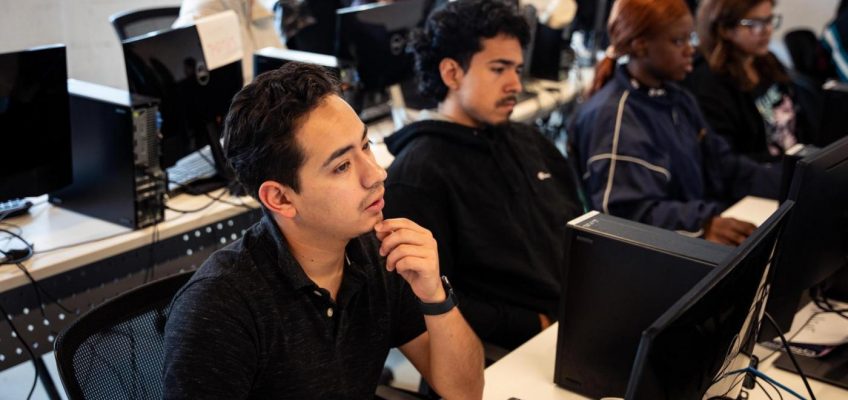By JAMES POLLARD
NEW YORK (AP) — Young jobseekers, challenged by a rapidly changing labor market, are having a tough time.
Related Articles
Wall Street drifts near its record heights
Wall Street rallies and gets near its all-time high
Weeklong strike ends at South St. Paul tannery after agreement reached
Regional banks’ bad loans spark concerns on Wall Street
Will tariffs slow the U.S. economy in 2026?
The U.S. unemployment rate for 22- to 27-year-old degree holders is the highest in a dozen years outside of the pandemic. Companies are reluctant to add staff amid so much economic uncertainty. The hiring slump is especially hitting professions such as information technology that employ more college graduates, creating nightmarish job hunts for the increasingly smaller number who do complete college. Not to mention fears that artificial intelligence will replace entry-level roles.
So, Citi Foundation identified youth employability as the theme for its $25 million Global Innovation Challenge this year. The banking group’s philanthropic arm is donating a half million dollars to each of 50 groups worldwide that provide digital literacy skills, technical training and career guidance for low-income youth.
“What we want to do is make sure young people are as prepared as possible to find employment in a world that’s moving really quickly,” said Ed Skyler, Citi Head of Enterprise Services and Public Affairs.
Employer feedback suggested to Citi Foundation that early career applicants lacked the technical skills necessary for roles many had long prepared to fill, highlighting the need for continued vocational training and the importance of soft skills.
Skyler pointed to the World Economic Forum’s recent survey of more than 1,000 companies that together employ millions of people. Skills gaps were considered the biggest barrier to business transformation over the next five years. Two-thirds of respondents reported planning to hire people with specific AI skills and 40% of them anticipated eliminating jobs AI could complete.
Some grantees are responding by teaching people how to prompt AI chatbots to do work that can be automated. But Skyler emphasized it was equally important they fund efforts to impart qualities AI lacks such as teamwork, empathy, judgment and communication.
“It’s not a one-size-fits-all effort where we think every young person needs to be able to code or interface with AI,” Skyler said. “What is consistent throughout the programs is we want to develop the soft skills.”
Among the recipients is NPower, a national nonprofit that seeks to improve economic opportunity in underinvested communities by making digital careers more accessible. Most of their students are young adults between the ages of 18 and 26.
NPower Chief Innovation Officer Robert Vaughn said Citi Foundation’s grant will at least double the spaces available in a program for “green students” with no tech background and oftentimes no college degree.
Considering the tech industry’s ever-changing requirements for skills and certifications, he said, applicants need to demonstrate wide-ranging capabilities both in cloud computing and artificial intelligence as well as project management and emotional intelligence.
As some entry-level roles get automated and outsourced, Vaughn said companies aren’t necessarily looking for college degrees and specialized skillsets, but AI comfortability and general competency.
“It is more now about being able to be more than just an isolated, siloed technical person,” he said. “You have to actually be a customer service person.”
Per Scholas, a no-cost technology training nonprofit, is another one of the grantees announced Tuesday. Caitlyn Brazill, its president, said the funds will help develop careers for about 600 young adults across Los Angeles, New York, Orlando, Chicago and the greater Washington, D.C area.
To keep their classes relevant, she spends a lot of time strategizing with small businesses and huge enterprises alike. Citi Foundation’s focus on youth employability is especially important, she said, because she hears often that AI’s productivity gains have forced companies to rethink entry-level roles.
Dwindling early career opportunities have forced workforce development nonprofits like hers to provide enough hands-on training to secure jobs that previously would have required much more experience.
“But if there’s no bottom rung on the ladder, it’s really hard to leap up, right?” Brazill said.
She warned that failing to develop new career pathways could hurt the economy in the long run by blocking young people from high growth careers.
Brookings Institution senior fellow Martha Ross said the fund was certainly right to focus on technology’s disruption of the labor market. But she said the scale of that disruption requires a response that is “too big for philanthropy” alone.
“We did not handle previous displacements due to automation very well,” Ross said. “We left a lot of people behind. And we now have to decide if we’re going to replicate that or not.”
Associated Press coverage of philanthropy and nonprofits receives support through the AP’s collaboration with The Conversation US, with funding from Lilly Endowment Inc. The AP is solely responsible for this content. For all of AP’s philanthropy coverage, visit https://apnews.com/hub/philanthropy.




